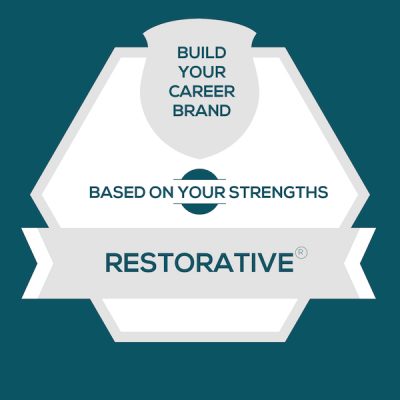Restorative Strength – Build A Genuine Career Brand
Podcast: Play in new window
Subscribe: Spotify | iHeartRadio | Email | TuneIn | More
 Restorative Strength: Get Known For Your Talent
Restorative Strength: Get Known For Your Talent
I get gobs of questions about how to align your CliftonStrengths talent theme of Restorative with your career.
So in this series, I break down one strength per post so that you can add to the insights from your StrengthsFinder report and make a better match between your job and your strengths.
- If you’re exploring as a manager, use this series for career development ideas and even new clues about responsibilities you could give a person with this talent theme so that they can show up at their best.
- If you’re exploring for yourself, use this as a chance to build a reputation for your strengths so that you’re more likely to be given assignments that live in your strengths zone.
Today, the talent theme of the post is Restorative.
You’ll get three layers to chew on:
- Career Branding
- Red Flag Situations At Work
- Fresh Application Ideas
Career Branding For The Restorative Strength
You probably already have a reputation for what you know. If you imagine your resume or your LinkedIn profile, I bet it's full of “the what,” which are things like job titles, skills, knowledge, expertise, or the degree you earned. Now, what’s missing in most of them is "the how,” and this is where your StrengthsFinder talent themes live. This is an overlooked use for LinkedIn, which is not just for job seekers.
I bet you are just like my StrengthsFinder training clients, where you don’t see your teammates and customers every day. That’s why LinkedIn has become so important for career branding. It’s how your teammates, customers, and vendors go look you up before a meeting - to see who they’re about to talk to. And rather than only telling them what you know, you should also give them a peek at how it is to work with you.
Here are a bunch of adjectives to consider using in your career branding efforts and your LinkedIn profile when you lead through the Restorative strength:
- Problem-Invader
- Organizational-Resuscitator
- Unintimidated By Big Problems
- Root Cause Finder
- Diagnoser
- Fixer (Or Fixer-Upper)
- Realistic
- Investigator
- Rehabilitator
- Accountable
- Unintimidated
- Responsive
- Troubleshooter
Red Flag Situations When You Lead With The Restorative Strength
These are the cultures, interactions, or situations that feel like soul-sucking drudgery to someone with the talent theme of Restorative. They might even make you want to quit the team. So I’ll give you a couple of these to be on watch for — because if they fester, you might get the urge to quit the job or become detached and disengaged at work.
Here are a couple of Red flags for the Restorative strength (talent theme):
- False Harmony. If you lead through the Restorative strength and you have a team culture where people are outwardly harmonious (when they don’t actually agree) — where they fake their agreement and go through great lengths to be conflict avoidant, you will probably feel super drained by that.
- Sweeping Issues Under the Rug. If you keep getting responses to your problem-solving ideas that sound like, “Well that’s not really something we own” or “That will never work here” or “No one else seems worried about it, so let’s not make mountains out of molehills” — you will be soul-sucked because you’re around people who are ignoring problems that you’d be happy to solve.
3 Fresh Application Ideas For The Restorative Strength
These are ways to apply the talent theme of Restorative at work , even when the job duties on the team feel pretty locked in. If you’re listening as a team manager, be sure to have a conversation around these ideas. You’ll both be able to come up with places to apply them.
For someone who leads through the Restorative strength, put the talent to good use with one of these options:
- Give them your big, hairy problems. Many managers feel bad delegating problems. Yet problems are a treat for people who lead through Restorative. Tell them why you assigned them, and that you know they’ll be able to diagnose and propose at a level that few people can do.
- Get them assigned to solving problems for your best or biggest customers. This person will enjoy the challenge of discovering and removing the obstacles. You can rest assured that they’ll go about it in a businesslike, focused way (rather than the emotional panic that many would get into).
- When you're stuck. When you catch anyone on the team saying, "I’m stumped” or “I’m baffled” or “I don’t know what to do” — consider partnering them with your team member with Restorative. This person has fun finding the root causes and helping people decide how to move forward.
So there you have it. It’s a quick tour for building your career through the talent theme of Restorative.
Here's Your Personal Branding Homework For The Restorative Strength
- Go take action on your LinkedIn profile with the career branding section. Challenge yourself to write one sentence in the Summary section of LinkedIn that captures how you collaborate as a teammate at work.
- Then think over the red flags to see if there’s anything you need to get in front of before it brings you down.
- Volunteer your talents through the application ideas. And if you’re a manager, have a conversation with your team members about which of these things sound like something they’d love to have more of.
- Dig into the Restorative strength all the way. You can really nerd out on the nuances on the Restorative Talent Theme Page.
Here's A Full Transcript Of The 8 Minute Episode
You're listening to Lead Through Strengths, where we help teams apply their greatest strengths at work. I'm your host, Lisa Cummings and I gotta tell you, it's hard to find something more energizing than using your natural talents every day at work.
And, as you might guess, I get a lot of questions about how to align your CliftonStrengths, talent themes with a career. So, in this series, I break down one strength per episode. This time, it's Restorative, so that you can add the insights you got from your StrengthsFinder report and make a better match between the job and the strengths.
So, if you're listening as a manager, use this series for career development ideas, and use it to get clues about responsibilities, tasks, and assignments you could give a person who has this talent theme, so that they can show up at their best. If you're listening for you, because you have Restorative, use this as a chance to build a reputation that is built on your problem-solving prowess, so that you're more likely to be given assignments that live in your strengths zone.
So, you're going to get 3 layers to chew on today. One is career branding. The second is red flag situations at work. And the third is fresh application ideas.
So, to start with career branding for Restorative, you probably already have a reputation for what you know. And if you imagine your resume or your LinkedIn profile, it's probably full of the what, which are things like the titles you've had, skills that you have, knowledge, expertise, or even your degree. But what's missing in most resumes and LinkedIn profiles is the how. And this is exactly where your StrengthsFinder talent themes live.
This is an overlooked use for tools like LinkedIn. This tool is not just for job seekers. I bet you're like most of my StrengthsFinder training clients where you don't see your teammates and customers every day. And that is exactly what makes LinkedIn become important for career branding, because it's how your teammates and your customers and your vendors go look you up. They check you out before a meeting because they want to see who they're about to talk to. And rather than only telling them what you know, what skills or knowledge or job titles you have had from the past, you should also be giving them a peek at how it is to work with you.
So here are a bunch of words and phrases you can use in your career branding, and in your LinkedIn profile. So, if you lead through Restorative, you are likely a problem invader. I think of this like space invaders, if you remember that, “peew, peew, peew!” like shooting the problems down.
You are an issue CPR-giver, like you can resuscitate things back to their original state. You're a root cause finder. You're a diagnose. You're a fixer or a fixer-upper. You're probably realistic. You're an investigator. You're rehabilitator. You're accountable. You're unintimidated by problems. You're responsive, you're a troubleshooter, all sorts of great words that get to your superpower of solving problems.
Now let's move to the red flag situations at work. These are the types of work cultures, the kinds of interactions or the kind of situations that are going to feel like real soul-sucking drudgery to those with the Restorative talent theme. They might even make you want to quit the team. And that's important to know.
So, I'll give you a couple of these to be on watch for because if you let them fester, you're probably going to get the urge to quit the job or become detached or disengaged on the job. So, 2 red flags for Restorative.
One, false harmony. If you lead through Restorative and you have a team culture where people are nice, even when they don't agree, but in a way where they're faking their agreement, and they're going through great lengths to be conflict-avoidant, then you're probably gonna feel super drained by that.
[3:59] The second is sweeping issues under the rug. If you keep getting responses to your problem-solving ideas that sound like somebody saying, -
“Well, we don't really… that's not really something we own. We can't really be the ones who fix that.” Or,
“Well, that will never work here, because we've tried it in the past.” Or things like, -
“Well, you know, no one really seems that worried about it. So, let's not make mountains out of molehills.”
If you get those kinds of dismissive answers about the important problems you're spotting and the solutions that you would like to bring to them, then you're going to feel soul-sucked, because when you're around people who are ignoring problems that you would be happy to solve, you're just going to be baffled about why someone would live like that.
So, here are 3 fresh application ideas to put Restorative to good use. If you're listening to this as a manager, which is how I'll frame the suggestions, then think about how you could offer these kinds of roles or responsibilities or tasks to someone who leads through Restorative. And if you're listening for yourself, be thinking about how to have these conversations with your manager about how you're going to volunteer these talents at the office.
Okay, option one. If you're leading someone through Restorative, give them your big hairy problems. It sounds really funny. But a lot of managers feel bad, they feel some guilt about delegating problems, especially the tough ones to people on their team. But this is actually a treat for people who lead through Restorative. So, tell them why you assigned it to them. Tell them that it's a big, hairy, awful problem and that, you know, they're just the person who can diagnose and propose a level that very few people can do.
Next idea, get them assigned to solving problems for your best customers, or for your biggest customers. Because this person's going to enjoy the challenge of discovering obstacles, removing obstacles. You can just rest easy that they're going to go about this in a businesslike focused way. They're not going to be in emotional panic, like some people would get into if the big customer was at risk because of a problem. Someone with the Restorative is a great person to assign that to.
The third thing that you can assign someone with Restorative I call it, “I'm stumped”. This is when you catch anybody on the team saying, “I'm stumped”, or, “I'm baffled”, or, “I don't know what to do.” Consider partnering them up with your team member who has the Restorative talent, because the person with the Restorative talent has fun figuring out the root causes, has fun making sure you're really solving the right problem, or helping people decide how to decide or how to move forward.
So, there you have it, it's a quick tour for building a career through the talent theme of Restorative. So, the homework is, number one: if you have that talent theme, go to your LinkedIn profile. Think about those words that describe someone with the Restorative talent theme and challenge yourself to write one sentence in the summary section that captures how you collaborate.
And the second one: think over those red flags. If you have this talent theme, whew, see, if you need to get in front of something before it brings you down. If you manage someone with this talent theme, and you see that those are major parts of your culture, be on watch for this and have conversations with the team member about how you can get around that situation.
And third: it's about volunteering the talents and applying the talents. So, if you're a manager, find the person on your team who you can assign these kind of Restorative application ideas to. If this is you who has Restorative, then think about how you're going to volunteer these talents and how you could offer them up to your manager so that it's known that you would love to work in this area.
So, with that, I'm your host, Lisa Cummings, from Lead Through Strengths. If you're thinking about doing a virtual or an in-person event to kick off your strengths-based culture, head on over to leadthroughstrengths.com/training to see if one of our StrengthsFinder or leadership offerings are a good fit for you.
So, until next time. Thank you for being part of this powerful strengths movement that helps people unleash the awesomeness that they already have inside them.

